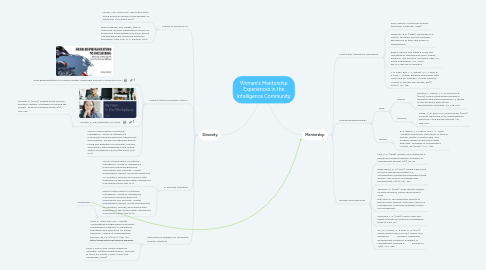
1. Diversity
1.1. History of Women in IC
1.1.1. Mundy, Liza. Code Girls: The Untold Story of the American Women Code Breakers of World War II (Hatchet, 2017)
1.1.2. Brian Kilmeade, Don Yaeger, and Inc OverDrive. George Washington's Secret Six [OverDrive Downloadable Electronic Book]: The Spy Ring That Saved the American Revolution. New York, N.Y.: Sentinel, 2013.
1.2. Current Status of Women in the IC
1.2.1. From Representation to Inclusion Military Leadership Diversity Commission.pdf
1.2.2. Women_in_the_Workplace_2017.pdf
1.2.2.1. Cormier, D. (2007). Retaining Top Women Business Leaders: Strategies for Ending the Exodus. Business Strategy Series, 8(4), 262-269.
1.2.3. Office of the Director of National Intelligence. Office of Intelligence Community Equal Employment Opportunity and Diversity. Annual Demographic Report: Hiring and Retention of Minorities, Women, and Persons with Disabilities in the United States Intelligence Community Fiscal Year 2017.
1.3. IC Diversity Initiatives
1.3.1. Office of the Director of National Intelligence. Office of Intelligence Community Equal Employment Opportunity and Diversity. Annual Demographic Report: Hiring and Retention of Minorities, Women, and Persons with Disabilities in the United States Intelligence Community Fiscal Year 2017.
1.3.2. Office of the Director of National Intelligence. Office of Intelligence Community Equal Employment Opportunity and Diversity. Annual Demographic Report: Hiring and Retention of Minorities, Women, and Persons with Disabilities in the United States Intelligence Community Fiscal Year 2016.
1.3.2.1. Mentorship
1.4. Theoretical Framework for Analyzing Diverity Initiatives
1.4.1. Jesse E. Olsen and Luis L. Martins. “Understanding Organizational Diversity Management Programs: A Theoretical Framework and Directions for Future Research." Journal of Organizational Behavior 33, no. 8 (2012): 1168-187. http://www.jstor.org/stable/41683990.
1.4.2. Carol T. Kulick and Loriann Roberson. “Diversity Initiative Effectiveness,” Diversity at Work, ed. Arthur P. Brief. (New York: Cambridge, 2008).
2. Mentorship
2.1. Mentorship Theoretical Framework
2.1.1. Kram, Kathy E. Mentoring at Work. (Glenview, Foresman, 1985).
2.1.2. Fagenson, E. A. (1988). The power of a mentor: Proteges and non proteges perceptions of their own power in organizations.
2.1.3. Ragins, Belle R. and Kathy E. Kram The Handbook of Mentoring at Work: Theory, Research, and Practice. Thousand Oaks, CA: SAGE Publications, Inc., 2007. doi:10.4135/9781412976619.
2.1.4. T. D. Allen, Eby, L. T., Poteet, M. L., Lentz, E., & Lima, L. “Career Benefits Associated With Mentoring for Proteges: A Meta-Analysis.” Journal of Applied Psychology, 89(1), (2004): 127-136.
2.2. Mentoring Relationships
2.2.1. Type
2.2.1.1. Formal
2.2.1.1.1. Tennent, L., Ehrich, L. C, & Hansford, B. (2004). Formal mentoring programs in education and other professions: A review of the literature. Educational Administration Quarterly, 40, 518-540.
2.2.1.2. Informal
2.2.1.2.1. Singh, V., D. Bains & S. Vissnicombe, (2002). Informal Mentoring as an Organizational Resource. Long Range Planning, 135, 389-405.
2.2.2. Gender
2.2.2.1. B. R. Ragins, J.L. Cotton, and J. S. Miller, “Marginal mentoring: The effects of type of mentor, quality of relationship, and program design on work and career attitudes.” Academy of Management Journal, 43 (2000): 1177- 1194.
2.3. Women and Mentoring
2.3.1. Noe, R. A. (1988). Women and mentoring: a review and research agenda. Academy of Management Review, 13(\), 65-78.
2.3.2. Blake-Beard, S. D. (2001). Taking a hard look at formal mentoring programs: a consideration of potential challenges facing women. The Journal of Management Development, 20(4), 331- 345.
2.3.3. Tharenou, P. (2005). Does mentor support increase women's career advancement more than men's? The differential effects of psychosocial support. Australian Journal of Management. Australian Graduate School of Management.
2.3.4. Scandura, T. A. (1992). Mentor ship and career mobility: an empirical investigation. Wiley & Sons, Inc.
2.3.5. Ely, R. J., Ibarra, H., & Kolb, D. M. (2011). Taking Gender into Account: Theory and Design for Women’s Leadership Development Programs. Academy of Management Learning & Education, 10(3), 474–493.

